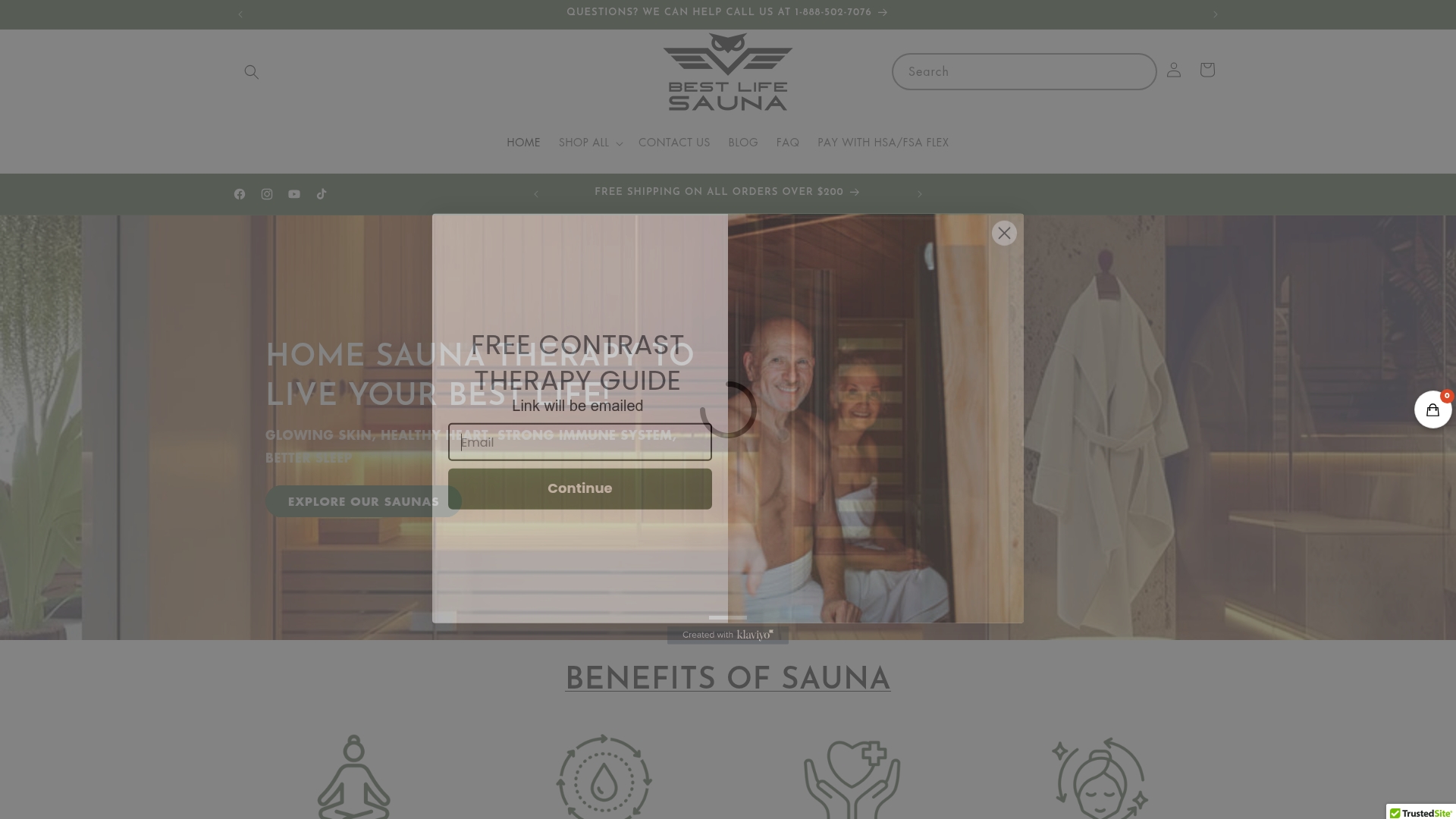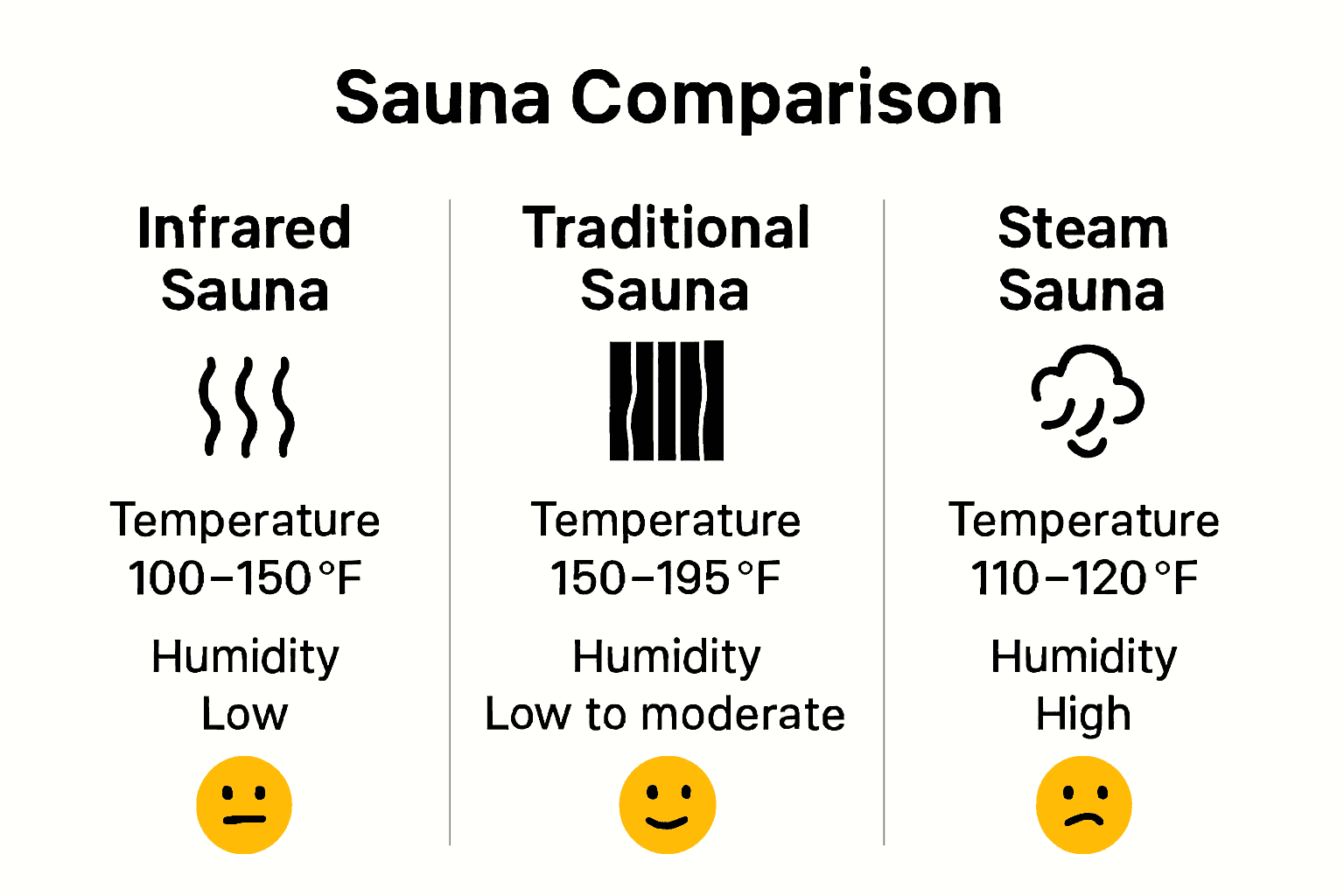
Sauna for Weight Management: Complete Guide
Sweating it out in a sauna can do more than just help you relax. Sauna sessions have been shown to temporarily raise your heart rate and mimic the calorie-burning effects of moderate exercise. For anyone seeking effective weight management tools, understanding how heat exposure affects your body is key. This guide explains how different sauna types support temporary fat loss, reveals practical health benefits, and clears up common myths so you can make the most of your wellness routine.
Table of Contents
- Understanding Sauna Weight Management Mechanisms
- Comparing Infrared, Traditional, And Steam Saunas
- Health Benefits Beyond Weight Management
- Effective Sauna Routines For Fat Loss Support
- Risks, Precautions, And Common Misconceptions
Key Takeaways
| Point | Details |
|---|---|
| Metabolic Benefits | Sauna sessions can temporarily increase heart rate and calorie expenditure, making them a complementary strategy for weight management. |
| Sauna Types | Infrared, traditional, and steam saunas offer distinct heat therapy experiences; choose based on personal preference and wellness goals. |
| Holistic Health Advantages | Regular sauna use supports cardiovascular health, muscle recovery, and stress reduction, enhancing overall well-being. |
| Safety Precautions | Hydration is crucial to prevent dehydration; always listen to your body and consult a doctor if you have health concerns before regular use. |
Understanding Sauna Weight Management Mechanisms
Sauna sessions represent a fascinating intersection of heat exposure and metabolic response, offering potential pathways for supporting weight management goals. When you step into a sauna, your body undergoes a series of intricate physiological changes that can impact metabolism and calorie expenditure. According to research from the National Center for Biotechnology Information, sauna bathing triggers significant metabolic adaptations that may contribute to temporary weight management effects.
The primary weight management mechanisms in saunas involve several key physiological processes. Metabolic Acceleration occurs as your body works to cool itself, increasing heart rate and peripheral blood circulation. This internal cooling process requires energy, which translates to additional calorie burning. The NCBI research highlights that sauna sessions can temporarily elevate heart rate similar to moderate cardiovascular exercise, creating a mild thermogenic effect that supports metabolic activity.
However, it’s crucial to understand the nuanced nature of sauna weight management. While heat exposure can induce short-term fluid loss and marginally increase calorie expenditure, sustainable weight management requires a comprehensive approach. Saunas should be viewed as a complementary strategy, not a primary weight loss method. The most effective results come from combining sauna sessions with consistent exercise, balanced nutrition, and overall healthy lifestyle practices. Key benefits beyond potential weight management include stress reduction, improved circulation, and muscle recovery.
- Metabolic Benefits: - Temporary increase in heart rate - Mild calorie expenditure - Enhanced peripheral blood circulation
Pro Tip: Always stay hydrated during and after sauna sessions to support your body’s natural thermoregulation processes and maximize potential metabolic benefits.
Comparing Infrared, Traditional, and Steam Saunas
The world of saunas offers three distinct heat therapy experiences, each with unique characteristics and potential health benefits. Infrared, traditional, and steam saunas provide different approaches to heat exposure, catering to diverse user preferences and wellness goals. According to NCBI research, these sauna types demonstrate significant variations in heat delivery, physiological responses, and overall user experience.
Infrared Saunas represent a modern approach to heat therapy, utilizing electromagnetic waves that penetrate directly into body tissues. Unlike traditional saunas, infrared models operate at lower temperatures typically ranging from 110-140°F, allowing for longer, more comfortable sessions. The radiant heat targets body tissues more precisely, potentially offering deeper therapeutic effects. These saunas are known for their energy efficiency and ability to induce significant sweating at lower ambient temperatures.
In contrast, Traditional Saunas deliver heat through high-temperature air and steam, creating a more intense environmental experience. Temperatures typically range between 150-195°F, with humidity levels that can be manually controlled. Steam Saunas, a subset of traditional models, introduce additional moisture, creating a more humid environment that can feel more intense and potentially more challenging for some users. The NCBI comparative review highlights that each sauna type triggers unique physiological responses, making individual preference and personal health goals crucial in selecting the right experience.
Comparative Overview
-
Infrared Saunas
- Lower temperature range (110-140°F)
- Direct tissue penetration
- More energy efficient
- Gentler heat experience
-
Traditional Saunas
- Higher temperature range (150-195°F)
- Ambient heat distribution
- More intense thermal experience
- Classic sauna atmosphere
-
Steam Saunas
- High humidity levels
- Intense moisture environment
- Potential respiratory benefits
- Similar to traditional sauna structure
Pro Tip: Consider your personal heat tolerance, health objectives, and comfort level when choosing between infrared, traditional, and steam sauna experiences. Each type offers unique benefits, so experimenting can help you find your ideal heat therapy approach.

Health Benefits Beyond Weight Management
Saunas offer a remarkable range of health benefits that extend far beyond simple weight management, presenting a holistic approach to wellness and physical recovery. According to NCBI research, regular sauna use can trigger profound physiological responses that support overall health and well-being. These heat therapy sessions provide a comprehensive approach to enhancing both mental and physical performance.
Cardiovascular Health emerges as a significant benefit of consistent sauna use. The controlled heat exposure creates a cardiovascular response similar to moderate exercise, promoting improved blood circulation and potentially reducing blood pressure. The NCBI study highlights that regular sauna bathing can stimulate heart rate variability, which is a key indicator of cardiovascular fitness. This gentle stress on the cardiovascular system may contribute to enhanced heart health and improved overall endurance.
Beyond cardiovascular benefits, saunas demonstrate remarkable potential for muscle recovery and stress reduction. The deep heat penetration helps relax muscle tissues, reduce inflammation, and accelerate post-exercise recovery. Heat exposure triggers the release of endorphins, creating a natural stress-relief mechanism that can improve mental clarity and emotional well-being. The combination of physical relaxation and neurochemical changes makes sauna sessions a powerful tool for holistic health management.
Comprehensive Health Benefits
-
Cardiovascular Improvements
- Enhanced blood circulation
- Potential blood pressure regulation
- Improved heart rate variability
-
Muscular Recovery
- Reduced muscle soreness
- Decreased inflammation
- Accelerated recovery time
-
Mental Wellness
- Stress hormone reduction
- Improved mood
- Enhanced relaxation response
Pro Tip: Integrate sauna sessions gradually into your wellness routine, starting with shorter durations and lower temperatures to allow your body to adapt and maximize the potential health benefits.
Effective Sauna Routines for Fat Loss Support
Creating an effective sauna routine requires a strategic approach that goes beyond simple heat exposure. According to NCBI research, successful fat loss support through sauna sessions demands a comprehensive strategy that integrates heat therapy with overall fitness and nutrition goals. Intentional sauna usage can become a powerful complementary tool in your weight management journey.
Frequency and Duration play critical roles in maximizing sauna benefits for fat loss. The NCBI study suggests that 3-4 sauna sessions per week, lasting between 15-30 minutes, can potentially support metabolic health and complement existing weight management efforts. Beginners should start with shorter 10-15 minute sessions, gradually increasing duration as body adaptation occurs. Timing is equally important - consider scheduling sauna sessions post-workout when metabolism is already elevated, creating a synergistic effect for potential fat loss.
To optimize fat loss support, combine sauna routines with strategic lifestyle practices. Hydration becomes paramount, as proper fluid intake supports metabolic processes and helps manage temporary water weight fluctuations. Nutrition Integration is crucial - focus on balanced, protein-rich meals and complex carbohydrates to support muscle recovery and metabolic function. The sauna should be viewed as a supplement to, not a replacement for, consistent exercise and balanced nutrition.
Sauna Fat Loss Strategy
-
Pre-Sauna Preparation
- Hydrate thoroughly
- Light stretching
- Wear comfortable, breathable clothing
-
Optimal Session Structure
- Start with 10-15 minute sessions
- Gradually increase to 25-30 minutes
- Allow 15-20 minute cool-down period
-
Post-Sauna Recovery
- Rehydrate with electrolyte-rich fluids
- Consume protein for muscle recovery
- Rest and allow body temperature to normalize
Pro Tip: Listen to your body and progress gradually. Sauna effectiveness varies individually, so pay attention to how you feel and adjust your routine accordingly.
Risks, Precautions, and Common Misconceptions
Sauna use, while generally beneficial, requires a nuanced understanding of potential risks and responsible practices. According to NCBI research, numerous misconceptions surround heat therapy that can lead to inappropriate or unsafe usage. Understanding these potential pitfalls is crucial for maintaining a safe and effective sauna experience.
Dehydration represents the most significant risk associated with sauna sessions. The NCBI study emphasizes that excessive heat exposure can rapidly deplete body fluids, potentially leading to heat exhaustion or more serious heat-related illnesses. Certain populations face heightened risks, including individuals with pre-existing cardiovascular conditions, pregnant women, and those taking medications that affect temperature regulation. Medical Consultation is strongly recommended before initiating regular sauna routines, especially for individuals with underlying health conditions.
Common misconceptions can create unrealistic expectations about sauna benefits. Many people erroneously believe that sauna sessions alone can produce significant weight loss or replace structured exercise. In reality, saunas should be viewed as a complementary wellness practice, not a standalone solution for fitness or weight management. The temporary water weight loss experienced during a session is quickly restored through rehydration, and any metabolic benefits are modest compared to consistent physical activity and proper nutrition.
Key Safety Considerations
-
Hydration Strategies
- Drink water before session
- Bring water into sauna
- Replenish electrolytes after use
-
Warning Signs to Stop Sauna
- Dizziness
- Rapid heartbeat
- Extreme fatigue
- Difficulty breathing
-
Recommended Precautions
- Limit initial sessions to 10-15 minutes
- Avoid alcohol before/during sauna
- Listen to your body
- Exit immediately if feeling unwell
Pro Tip: Start slowly, stay hydrated, and never view saunas as a magical solution. They’re a wellness tool - not a miracle cure.
Elevate Your Weight Management Journey with the Right Sauna Solution
Struggling to find a natural and relaxing way to support your weight management goals? This guide revealed how sauna sessions can boost your metabolism, aid muscle recovery, and enhance calorie burning through targeted heat exposure. If you want to turn these benefits into lasting results, choosing the right sauna type and routine is essential. From infrared to traditional saunas, understanding your perfect fit can help you stay motivated and comfortable while maximizing your wellness journey.

Discover a carefully curated selection of premium saunas and wellness products designed to complement your weight management efforts at Best Life Sauna. Whether you prefer the gentle deep tissue heat of infrared or the classic atmosphere of a traditional sauna, you can find your ideal match. Start transforming your routine today by exploring our exclusive sauna offerings, supported by trusted customer reviews and a price match guarantee. Don’t wait to experience the combined power of heat therapy and holistic wellness. Visit Best Life Sauna now and take the first step toward a healthier, revitalized you.
Frequently Asked Questions
What are the primary weight management mechanisms of sauna use?
Sauna sessions primarily enhance metabolic acceleration, increasing heart rate and peripheral blood circulation, which can lead to additional calorie burning. This process occurs as the body works to cool itself, similar to moderate exercise.
How long should I stay in the sauna for effective weight management?
For effective weight management, it is recommended to have 3-4 sauna sessions per week, lasting between 15-30 minutes each. Beginners can start with 10-15 minute sessions and gradually increase the duration.
What are the different types of saunas, and how do they compare?
There are three main types of saunas: Infrared, Traditional, and Steam. Infrared saunas operate at lower temperatures (110-140°F), using radiant heat to penetrate tissues effectively. Traditional saunas provide a higher temperature (150-195°F) through hot air, while steam saunas add humidity for an intense moisture environment. Each type caters to different preferences and wellness goals.

Are there any risks or precautions I should consider when using saunas?
Yes, hydration is crucial, as dehydration can occur with excessive heat exposure. Individuals with certain health conditions, such as cardiovascular issues or pregnant women, should consult a medical professional before using saunas. Always listen to your body and exit the sauna if you experience dizziness, rapid heartbeat, or extreme fatigue.

